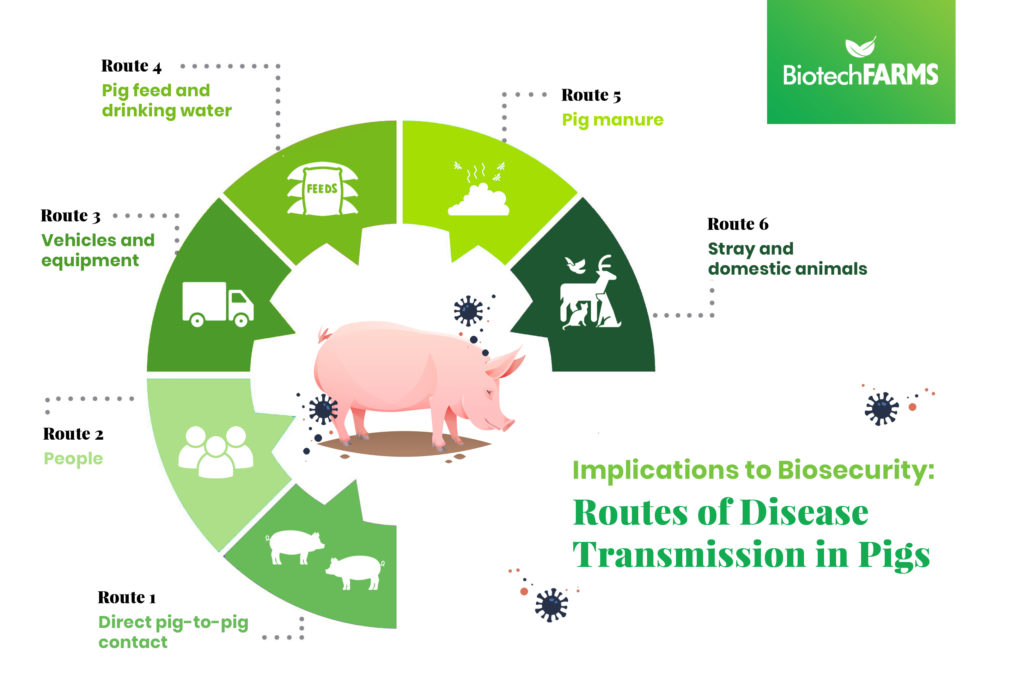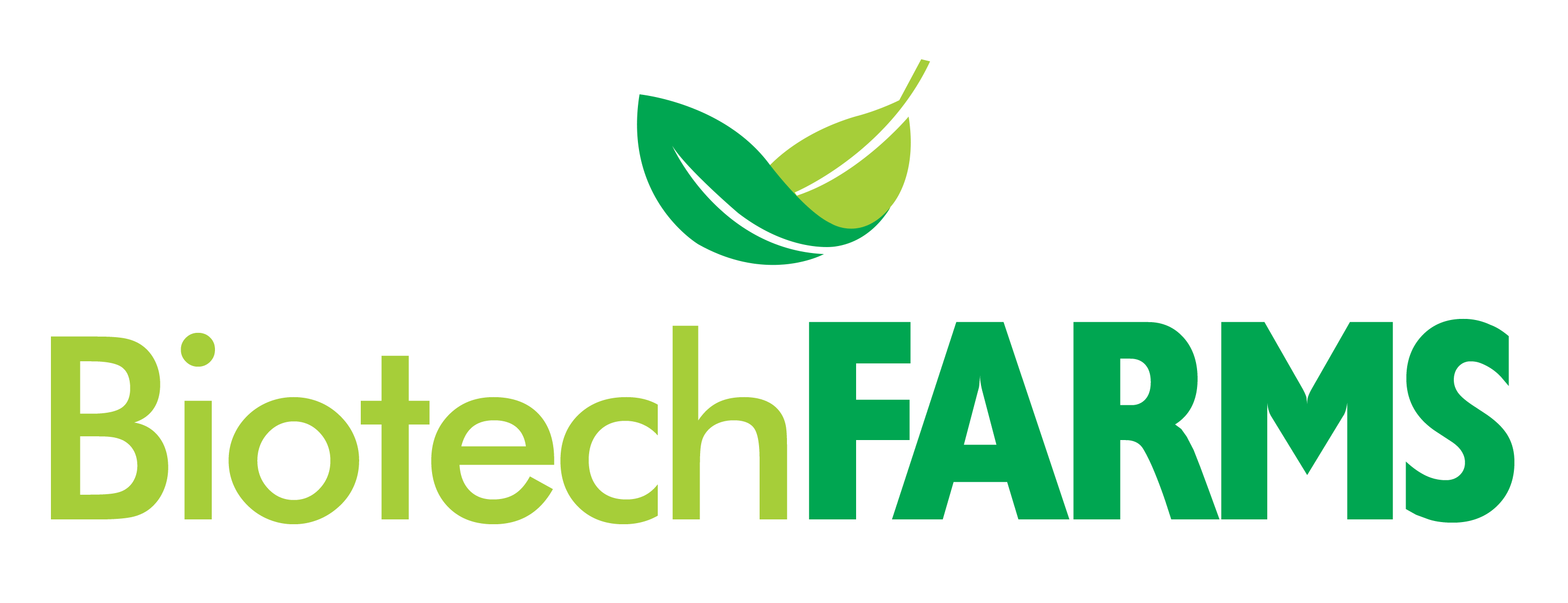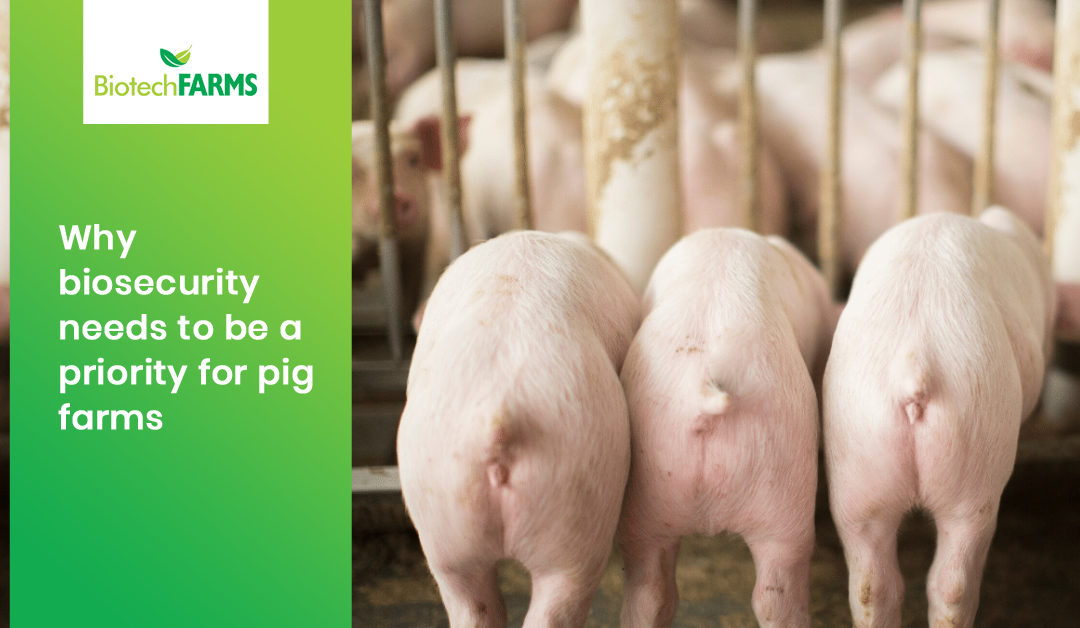The emergence of the African Swine Fever (ASF) virus in the Philippine swine industry over the past year has once again drawn attention to the potential threat of viruses hosted in animals.
This occurrence provokes considerable national concern since the dwindling supply of pork is causing its price to skyrocket. Over the past year, the ASF virus has had a significant impact on human health and people’s livelihoods, with devastating effects on our country’s agricultural economy.
Consequently, the importance of pig farm biosecurity was also taken into consideration as ASF outbreaks spread not just in the Philippines but also in other countries.
Why is biosecurity essential in pig farms?
Biosecurity is frequently understood as the prevention of entrance of infection into a pig farm. However, implementing full-blown biosecurity also means controlling the spread of disease within the farm.
Understanding the essence of biosecurity principles will help limit pig-to-pig transmission of disease and reduce the impact of spreading infectious swine diseases like ASF, including its economic losses.
Biosecurity at the farm level should implement protocols to protect a farm from both the entry of diseases and its internal transfer among different areas of the farm.
External biosecurity measures in a pig farm need to be used to avoid disease pathogens’ entry into a farm. Internal biosecurity measures involve preventing disease to uninfected animals within a farm and to other farms when the pathogen is already present.
Here are the following main elements of biosecurity:

ELEMENT 1: Segregation
Segregation is considered as the primary element of biosecurity. It can be regarded as the most effective step in achieving the first level of biosecurity. Naturally, if a potential disease pathogen does not enter the farm, no infection will occur.
Farms need to follow a strict protocol wherein no animals or materials should enter or leave the facility unless absolutely necessary. This should include pigs and other species, including humans, that may potentially be infected with pathogens that can also infect pigs.
Segregation also involves creating barriers and controlling everything that will pass through it. The barriers can either be physical or temporary wherever needed and procedural whenever necessary.
However, keep in mind that these barriers can only be effective if it is controlled to exclude potentially contaminated items. Methods of enforcing this protocol include changing and washing footwear and clothing for all people crossing the biosecurity barrier and restricting entry of vehicles.
ELEMENT 2: Cleaning
The second most effective step in biosecurity is cleaning. Disease contamination often occurs in physical objects that adhere to the surface. As such, cleaning is an effective method of removing potential disease contamination.
Protocols should be kept in place wherein any material that must pass through the farm’s segregation barrier should be thoroughly cleaned. This means that there should be no visible dirt on the surface of the materials. For starters, soap, water, and a brush are good ways to clean small objects. However, it is recommended that a high-pressure washer is used for cleaning large vehicles and vans. There is an increased difficulty in cleaning large farming equipment, which is why biosecurity emphasizes the need for segregations as the first step to protect the farm.
ELEMENT 3: Disinfection
Disinfection is the final step of biosecurity. Disinfection is crucial to be administered consistently and correctly. However, it should be regarded as the last “finishing touch” in biosecurity after effective and comprehensive cleaning of the facility.
It’s also important to note that the effectiveness of disinfectants differs under ideal controlled conditions with proper biosecurity protocols from field conditions. There is also a high probability that disinfectants will not necessarily penetrate dirt in sufficiently high concentrations. As such, although it may be deemed as essential, disinfection can be considered as the least effective step in biosecurity.
Biosecurity serves as the foundation that will maintain the health of the pig production system. Within each of these critical elements, protocols taken to improve biosecurity depend on the pig production system concerned and its corresponding local geographic and socio-economic conditions.
Implications to Biosecurity: Routes of Disease Transmission in Pigs

ROUTE 1: Direct pig-to-pig contact
Diseases can be transmitted through direct contact between an infected pig and a healthy susceptible pig. This is considered as the most potent route of transmission for most pig diseases.
Disease transmission will occur when there is a sufficient dose of disease pathogen transmitted to a susceptible animal. This is why close, prolonged, or repeated contact between infectious pigs in pens or vans during transport will increase the likelihood of disease transmission.
ROUTE 2: People
The role of people in disease transmission has been studied closely over the last decade. They can transport pathogens on footwear, clothing, hands, etc. People can carry viruses on their nasal mucosae (nasal carriers) without being infected. People can also determine the movements of domestic animals and products among herds, markets, and regions. Economic forces can cause the pigs to move to various locations, which will further increase the geographical spread of diseases.
Thus, pig farmers need to be aware of their own potential role in spreading disease on their farms. Since they have physical contact with pigs in their daily movements around the farm, it will increase disease risk from spreading. Another equally problematic scenario is when pig farmers or their households keep pigs of their own or live along with neighboring wet markets or slaughterhouses.
ROUTE 3: Vehicles and equipment
Equipment used by pig farmers needs to be considered as potentially contaminated materials. Moreover, vehicles have a high probability of transmitting swine pathogens, like when manure containing disease agents adheres to tires or inside the transport vans. There is actually evidence that bacteria from ASF, Actinobacillus pleuropneumoniae and Streptococcus suis can be spread by contaminated vehicles. Trailers, vans, and even motorbikes used in transporting pigs or carcasses are a high risk for disease transmission.
ROUTE 4: Pig feed and drinking water
Feed and water can all become contaminated and play a role in maintaining diseases. Swill feeding is prohibited since disease pathogens can survive in contaminated meat waste. As such, specific attention needs to be administered to the use of food wastes or kitchen scraps in feeding pigs, especially for backyard pig farmers.
ROUTE 5: Pig manure
Feces from infected pigs can contain large quantities of pathogenic viruses, bacteria, or parasites. Consequently, the disposal of pig manure needs to be a primary consideration when it comes to designing and implementing biosecurity protocols within the pig farm. If the manure is not adequately treated, controlled, or disposed of, contamination from pig manure may pose a risk to the health of animals or even humans.
ROUTE 6: Stray and domestic animals
Birds, rodents, stray dogs and cats, wildlife, and feral pigs can all be potential carriers, whether through mechanical transmission or by being infected. There are widespread cases when animals like birds come into close contact with pigs when looking for food. They may contaminate the herd with bird droppings or by mechanical transfer. Meanwhile, rodents like rats and mice commonly live in close contact with pigs and are heavily involved in the endemic disease transmission in pig operations.
Step by step plan for preparing your pig farm to survive an ASF outbreak through biosecurity

Step 1: Think about the impact on your business.
The spread of disease on your pig farm can disrupt every aspect of your supply chain, which can have long-term effects on the profitability of your business. Understand the key areas of your business and supply chain that may be vulnerable such as:
| Area | Examples |
| 1. Key products and customers | retailers, pigs for food consumption, breeding stock |
| 2. Key inputs and suppliers | feed, bedding, veterinary supplies, fuel, staff, contractors, power and water providers |
| 3. Key support services and service providers | veterinarians, consultants, sales agents, transporters, mechanics, accountants, IT support, and industry stakeholders |
| 4. Key regulators | LGU (local government unit), Department of Agriculture – Bureau of Animal Industry, Department of Environment and Natural Resources, National Meat Inspection Service, etc. |
Step 2: Understand the risks
Following the detection and confirmation of the disease, a range of movement restrictions needs to be implemented within the pig farm. Restrictions can be as widespread as a national pork meat standstill or more localized in the form of having declared quarantine areas around infected and at-risk premises within the LGU.
Local and national restrictions may affect a pig farm’s ability to sell or move livestock, meat products, feed, and supplies. On-going disease control may prevent or restrain business activity of the farm for days, weeks, months, or even years.
Pig farmers need to understand what the following scenario will mean for the business and assess whether they will be able to survive:
- an outbreak on your farm that requires all of your livestock to be culled
- closure of export market access
- loss of income, staff, and suppliers
- movement restrictions on your livestock, products, fodder, vehicles, and equipment.
- emergency disease control activities such as vaccination, diagnostic testing, or culling, requiring your time, equipment, and other resources
Step 3: Identify the actions to take before and during an outbreak
Look through these risks and identify a plan of action that can help reduce the impact of a disease outbreak in your business:
RISK 1: Livestock Infection
The best way to minimize the impact of any disease is to avoid infection in the first place. However, if the disease is already present in your herd, the immediate goal will be to prevent further spread with the assistance of animal health authorities. Report suspicions of notifiable diseases to local authorities immediately.
RISK 2: Loss of Income
Disease outbreaks often cause market closure, and the subsequent loss of income and staff impose severe financial hardship on the Philippine swine industry and other related businesses. This is why actions taken to improve resilience can make a difference whether the pig farm survives the disease outbreak or not.
RISK 3: Farm Movement Restrictions
A primary principle of eradicating disease in pigs is to stop the movements of people, animals, and other stakeholders that could spread the disease. Depending on the range of the outbreak, farms may be placed under movement restrictions for months, making it very difficult to manage the feed supply to livestock and move animals from the farm.
RISK 4: Managing Disease Control Activities
Disease control requires cooperation with animal health authorities to help conduct surveillance, tracing, vaccination, valuation, animal destruction, carcass disposal, pest control, cleaning, and disinfection. Your farm’s ability to comply and assist with these disease control activities during an outbreak will significantly influence how long it will take for the business and the industry to return to normal.
Step 4: Prepare a biosecurity action plan.
Implement contingency measures within your pig farm to help prevent and control the disease. Pig farms are susceptible to a wide range of diseases that can affect the productivity and livelihood of any commercial producer.
Among all the proposed solutions that can minimize the risk of disease spread in a pig farm like ASF, the implementation of biosecurity protocols is a priority.
While it still does not reduce the need to invest in adequate resources to control disease outbreaks once they occur, it is still a proactive measure that has a preventive impact to help pig farms protect their assets. The measures to strengthen biosecurity in pig farms must consider the technical and financial capacity of stakeholders that will implement them.
For meaningful action to take place in the Philippine swine industry, a multi-sectoral approach is needed. The promotion of appropriate biosecurity measures goes hand-in-hand with a well-designed public service awareness plan that involves pre-emptive measures among the public health and agricultural sector.
As such, mutual cooperation and strengthened collaboration between the public and private sector is crucial for better disease control in a pig farm.
Biotech Farms takes food safety and security seriously.
There are many layers to a farm’s biosecurity management plan. At Biotech Farms, we adhere to our biosecurity protocols consistently and adequately. We understand that behind every farm’s success is the prevention of the entry of diseases.
To provide the best quality of pork, eggs, and rice to our customers, we consider biosecurity as an investment essential for the safety of animals, farmworkers, and the general public.
References:
Good practices for biosecurity in the pig sector – Issues and options in developing and transition countries. (2021). Retrieved 23 February 2021, from http://www.fao.org/3/i1435e/i1435e00.htm
Preparing your business to survive an emergency animal disease outbreak: A 30-Minute Plan for Piggeries (n.d.). Australian Pork | The producer owned organisation supporting & promoting the Australian Pork Industry. https://australianpork.com.au/wp-content/uploads/2019/10/Preparing-your-busines-to-survive-an-EAD-30-minute-piggery-plan.pdf


